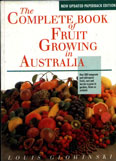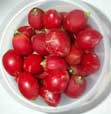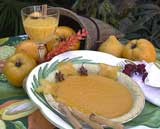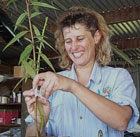February 2002 Newsletter

Thank you to all those customers who visited the nursery over the xmas break and took advantage of our special Christmas offers. We regret that we weren't able to offer the same specials to our online customers due to the extra costs incurred selling plants via mail order. However don't forget that all customers who order online have the opportunity to purchase 'the Complete Book of Fruit Growing in Australia' by Louis Glowinski for the wholesale price of just $29.00.
The first three customers to order fruit trees to the value of $100 or over and purchase a copy of the 'Complete book of fruit growing in Australia' will receive their copy signed by Dr Louis himself.
If you would like to purchase the book on an individual basis we have them available through mail order at a discounted rate of $37.95 + $8.00 postage and handling. RRP $49.50.
The Peanut Butter Fruit (Bunchosia argentea)  is just one of the delicious fruit bearing trees we sell that is regarded as highly underestimated. Apart from being a valuable tree for the fruit it bears it is also highly ornamental. It can be grown into a bush or a small tree with a tendency to go deciduous during the winter. The yellow flowers are produced through late Spring and are followed by a nearly constant production of fruits in varying quantities.
is just one of the delicious fruit bearing trees we sell that is regarded as highly underestimated. Apart from being a valuable tree for the fruit it bears it is also highly ornamental. It can be grown into a bush or a small tree with a tendency to go deciduous during the winter. The yellow flowers are produced through late Spring and are followed by a nearly constant production of fruits in varying quantities.
The dark-red to dark-orange fruit is the size of a quail egg and needs to be picked every day as they spoil quickly on the tree. They can be stored for several days in the refrigerator or can be separated from the seed and frozen. The skin is very tender with rich, sweet flesh that has a texture very similar to peanut butter or a sweet potato. The concentrated sugars of the fruit make it much like a dried fig. They are especially good when blended into a milkshake.
The trees, which have a distant affinity to the Acerola Cherry, are hardy and highly tolerant of frost. They grow quickly and produce from their first year.
THE CANISTEL - All you need to know about using this most versatile of fruits.
 This member of the SAPOTACEAE family produces a showy fruit and one of the most versatile in its uses. It is a slender, erect tree to around 8 metres tall however the grafted selections reach little over 4 metres. The evergreen leaves are thick, oblong, and glossy. The pretty cream flowers are slightly scented. The tree requires frost-free conditions and is easy to grow with minimal care due to its high wind resistance. It tolerates a wide range of soil types however performs best in well-drained soil. Mulching is most beneficial and a balanced fertiliser should be applied during growing seasons. Few pests and diseases attack the tree and it is nearly always vigorous and healthy.
This member of the SAPOTACEAE family produces a showy fruit and one of the most versatile in its uses. It is a slender, erect tree to around 8 metres tall however the grafted selections reach little over 4 metres. The evergreen leaves are thick, oblong, and glossy. The pretty cream flowers are slightly scented. The tree requires frost-free conditions and is easy to grow with minimal care due to its high wind resistance. It tolerates a wide range of soil types however performs best in well-drained soil. Mulching is most beneficial and a balanced fertiliser should be applied during growing seasons. Few pests and diseases attack the tree and it is nearly always vigorous and healthy.
The yellow-orange fruit of the Canistel has similar characteristics to cooked pumpkin. It is one of the most delicious exotic fruits added to milk products as it doesn't sour the milk like many other fruits do. The yellow flesh is relatively firm and mealy with the consistency of a boiled egg, hence its other common name of Eggfruit. The flesh is virtually fibreless and can be frozen for up to 6 months. Results are best if the flesh is mixed with sugar beforehand. Fruits begin to appear on 3 year old grafted trees and are best clipped from the tree shortly before maturity to avoid skin tearing with growth and droppage. Fruits ripen well at room temperature over a 3 - 10 day period. They should not be allowed to become too soft and mushy. Ripe fruit can be kept successfully in the vegetable bin of the refrigerator for several days. The Peruvians knew a nutritious fruit when they saw one. The Canistel is an excellent source of vitamin A and niacin and a fair source of vitamin C, calcium, iron and phosphorus. 100g of edible portion contains 139 calories, 2 g protein, and 37 g carbohydrates.
The fruit is very versatile and is delicious eaten fresh with salt, lemon juice and mayonnaise. The fruit can be enjoyed fresh or baked. It is used in a variety of desserts such as, custard, ice cream, milk shakes, and cakes. It can also be used to make pancakes, jams and marmalades. The canistel is also a good choice to dehydrate for longer storage.
Recipes:
Canistel Pie
 1 ½ cups mashed canistel 1 tsp Lime Juice
1 ½ cups mashed canistel 1 tsp Lime Juice
2/3 cups brown sugar 2 eggs, beaten
½ tsp salt 1 ¼ cups evaporated milk
¼ tsp nutmet Prepared pie crust
Mix dry ingredients first, add remaining ingredients, except pie shell. Pour into unbaked pie shell and bake at 200C degrees around 45 minutes. Serve warm or chilled, with whipped cream.
For more Canistel recipes click here .
Grafting and Budding
 For short-term results it is definitely advisable to plant grafted fruit trees. Most grafted fruit trees commence bearing in as little as 3 years which is good news for all fruit growers especially beginners. The grafted plants are good insurance ensuring good quality fruit and regular crops within the shortest possible time.
For short-term results it is definitely advisable to plant grafted fruit trees. Most grafted fruit trees commence bearing in as little as 3 years which is good news for all fruit growers especially beginners. The grafted plants are good insurance ensuring good quality fruit and regular crops within the shortest possible time.
Grafted plants have a vigorous and disease resistant rootstock while benefiting from the performance, quality and uniformity of the scion (top growth) sources from superior parent plants.
Having been in the business for over 20 years a number of our long term customers have come across superior varieties in their own orchards and would like to try their hand at grafting or budding.
The beauty of trying to graft is that a failed attempt doesn't necessarily mean the death of your plant. If the graft doesn't take just try again later. You might end up with a plant that bears a few battle scars but you will have gained a valuable and interesting skill. The following website gives concise instructions and offers clear black and white illustrations. Click here
Citrus - Pest & Disease Control
The webpage below is an excellent source of information for pest identification and control. It has numerous clear photographs and recommends good control measures. Click here to view.
To post your message please Contact Us





